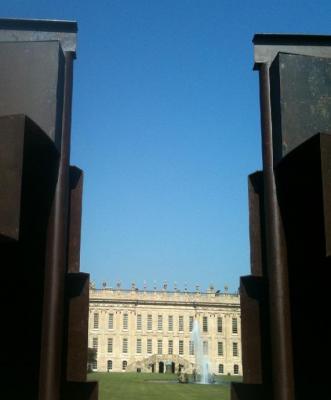Isabel Seligman investigates the unlikely tension between foundry and fountains, girders among the gardeners
Shining in 24-carat gold on Chatsworth’s famous facade, the family motto – ‘Cavendo tutus’ (‘safety through caution’) – can be picked out between the rusted steel ziggurats of Anthony Caro’s monumental ‘Goodwood Steps’. Although perhaps in some ways a safe choice (Caro has been hailed as Henry Moore’s successor since the fifties and is now touted as Britain’s greatest living sculptor), in others this exhibition is a distinctly daring one.
Famous for taking sculpture ‘off the plinth’, and making it more directly accessible to the viewer, it might seem strange for him now to be placing his work in such a rarefied position. The tension between his stark, industrial pieces, and their genteel surroundings creates a charged atmosphere; it’s foundry versus fountains, girders among the gardeners. ‘We must never allow sculpture to become punctuation. That’s what it was in the eighteenth-century garden’ claimed Caro in 2005. How then, do his sculptures fare in perhaps the most famous eighteenth-century garden of all?
The sculptures demand to be walked around, interrogated, made sense of in their surroundings. Despite their surprisingly personable scale, the space does not dwarf them, although his earlier pieces, painted in eye-popping colours, seem better equipped to hold their own – those in vibrant orange, red and mint green coerce their surroundings, and turn the lawns into a sort of gallery space. He has famously stated his preference for works shown indoors, yet the protruding growth of ‘Cliff Song’ calls to the boles of the trees behind it, the more spindly ‘Emma Gate’ to the budding branches, ‘Scorched Flats’ to the spread fan of a landscaped hillside. The black bolted and riveted ‘Lock’ (happily named for its placement at the end of the canal pond) seems like a railway turntable a very long way from home, yet manages to remain strange and alien without being apologetic.
All the above are strong enough to compete with their opulent setting, however some do fall a bit flat in this respect (most of the ‘Flats’ series unfortunately spring to mind). These works seem too thin, lacking the stage-presence of their beefier brothers, such as ‘Egyptian’ and the showpiece ‘Goodwood Steps’. The regularity, rhythm and symmetry displayed by these two allow the works to converse with the house itself, and have a truly architectonic feel.
There is no doubting the essential substance of these sculptures – the instantly recognisable ‘I-beams’, bolts and rivets all speak of an industrial heritage, which now seems perhaps as distant as Chatsworth’s agricultural one. Yet the two still have a lot to say to each other. To return to Caro’s earlier remark, punctuation is something that halts, links, or directs (like a sign-post). It has significance, but only in relation to the main text: punctuation means nothing in isolation. While Chatsworth may be the weighty tome to Caro’s imagist poems, his work is still able to stand alone, and the dialogue created between the two is worth the journey. Words/ Photo Isabel Seligman © 2012 ArtLyst
Follow ArtLyst on Twitter for breaking art news and latest exhibition reviews

